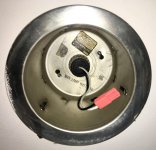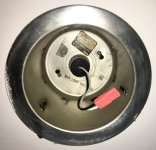Cheese said:
Packard said:
As promised here are photos of my Halo retrofit. It is ready to be pressed into place. Installation is a picture of simplicity. And it works fine. The problem is that the bezel of the Halo unit will stack on top of the bezel of the original installation.
And here it is installed, bezels stacked, pressed into final position. To avoid that stacked bezel appearance, I would have to use a right angle grinder inside the cylinder and make a cut around the entire perimeter. This would have to be done overhead, so goggles and a cap would be needed, and it would likely take 5 plus minutes per light to do.
Even from a distance it makes for an unfortunate look. I know that there are stamped steel versions out there. The stamping would probably completely cover the old bezel.
I’m disappointed in the look. The function is fine. At some point I will get the energy and initiative to fix this problem.
Can you pull the original can down at all? Even if you can only pull it down 1/2", you could slip a .040" cut-off wheel between the existing flange and the ceiling and use the flange as a cutting guide/rest. That would certainly ease the task and minimize the modification time.
Thinking about it further, those "flanges" must be removable or the can must be removable from the ceiling side, otherwise, how would they be installed originally?
I don’t recall what the obstacle was, but the old bezel cannot be removed from the can. I will look again later.
I can pull it down about 1” and working from the outside sounds easier. But if I can find a stamped version that covers the old bezel, I would probably just replace these.
I will take another look when I get home. But if you are thinking of doing the same thing as I did, look at the old bezel. The way I have it now, it looks sloppy and every time I walk in the room I see it.
At any rate, before buying these look at the old bezel and how you will deal with it. If you are like me, you will be disappointed with the stacked bezel look.




